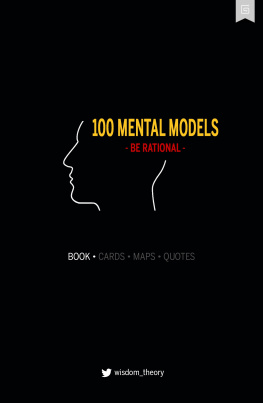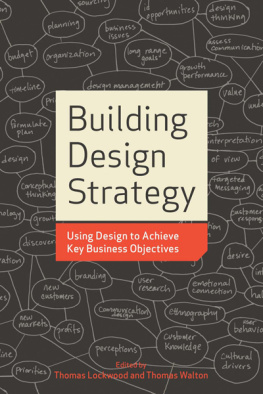Indi Young - Mental Models: Aligning Design Strategy with Human Behavior
Here you can read online Indi Young - Mental Models: Aligning Design Strategy with Human Behavior full text of the book (entire story) in english for free. Download pdf and epub, get meaning, cover and reviews about this ebook. City: Brooklyn, NY, year: 2008, publisher: Rosenfeld Media, LLC, genre: Business. Description of the work, (preface) as well as reviews are available. Best literature library LitArk.com created for fans of good reading and offers a wide selection of genres:
Romance novel
Science fiction
Adventure
Detective
Science
History
Home and family
Prose
Art
Politics
Computer
Non-fiction
Religion
Business
Children
Humor
Choose a favorite category and find really read worthwhile books. Enjoy immersion in the world of imagination, feel the emotions of the characters or learn something new for yourself, make an fascinating discovery.

- Book:Mental Models: Aligning Design Strategy with Human Behavior
- Author:
- Publisher:Rosenfeld Media, LLC
- Genre:
- Year:2008
- City:Brooklyn, NY
- Rating:5 / 5
- Favourites:Add to favourites
- Your mark:
- 100
- 1
- 2
- 3
- 4
- 5
Mental Models: Aligning Design Strategy with Human Behavior: summary, description and annotation
We offer to read an annotation, description, summary or preface (depends on what the author of the book "Mental Models: Aligning Design Strategy with Human Behavior" wrote himself). If you haven't found the necessary information about the book — write in the comments, we will try to find it.
Indi Young: author's other books
Who wrote Mental Models: Aligning Design Strategy with Human Behavior? Find out the surname, the name of the author of the book and a list of all author's works by series.
Mental Models: Aligning Design Strategy with Human Behavior — read online for free the complete book (whole text) full work
Below is the text of the book, divided by pages. System saving the place of the last page read, allows you to conveniently read the book "Mental Models: Aligning Design Strategy with Human Behavior" online for free, without having to search again every time where you left off. Put a bookmark, and you can go to the page where you finished reading at any time.
Font size:
Interval:
Bookmark:

By Indi Young
Rosenfeld Media, LLC
705 Carroll Street, #2L
Brooklyn, New York
11215 USA
On the web: http://www.rosenfeldmedia.com
Please send errors to:
Publisher: Louis Rosenfeld
Editor: Karen Whitehouse
Production Editor: Liz Danzico
Proofreader: Mary Jean Babic
Interior Design: Allison Cecil
Cover Design: Jason Kernevich
2008 Rosenfeld Media, LLC
All Rights Reserved
ISBN 1-933820-06-3
ISBN-13 9 781933 820064
Library of Congress Control Number: 2007930707
Printed and bound in the United States of America
This book is dedicated to my father, Evert Hale Young, Jr. His can do approach laid the perspective for my entire life.
Necessity is the mother of invention. Historically, tool designfrom a sharpened stone ax to a folding Japanese pruning sawhas been inspired by need. The designers themselves range from seemingly isolated genius inventors to cubicle farms of engineers with explicit specification documents. Really successful designthat which solves the problem, is easy to use, and is beautiful to behold while functioningis hit and miss. Innovation is elusive. Lots of money and hope are put towards products that look encouraging at the outset, but end up not quite reaching the mark. Entrepreneurs, investors, designers, engineers, and customers all get burned more often than they succeed.
There is no one method to follow to create perfect products. But there are many ways to increase the odds. One of them is to understand the reason for the tool in the first place. Deeply investigate what people are trying to get done and line up your solutions to match. Are you trying to solve a small part of a larger puzzle that could be simplified if you look at a broader context of the customers behavior and philosophies? Do you have so many aspects to your service that its hard to prioritize where to invest more development dollars?
As first a software engineer and then as a specialist in web applications, I had been doing this broad sort of task analysis for many years before I came up with a way to draw a picture of it alla mental model, which is an affinity diagram of user behaviors surrounding a particular topic. (See What is an Affinity Diagram? in Chapter 1; and see Appendix B (  http://www.rosenfeldmedia.com/books/mental-models/content/appendix_b ) for the story of how the technique evolved.) Mental models help me illustrate a profound understanding of the user, align solutions to areas that make a difference, and chart my way through a decade of development. When people saw the first diagrams, they encouraged me to share them in print. Seven years later, I can finally give you this book.
http://www.rosenfeldmedia.com/books/mental-models/content/appendix_b ) for the story of how the technique evolved.) Mental models help me illustrate a profound understanding of the user, align solutions to areas that make a difference, and chart my way through a decade of development. When people saw the first diagrams, they encouraged me to share them in print. Seven years later, I can finally give you this book.
Depending on your role , you might be interested in reading certain chapters first. I anticipate that a lot of you will be practitioners actually creating mental models. I also hope that many of you are responsible for product strategydirectors and executivesand are interested in how mental models can help guide your decisions. For those of you who are project managers and team managers within large organizations, I have included information about how to run a mental model project successfully as a part of a network of other research and design projects. And for all of you who need to persuade key people in your business to cultivate a better understanding of the people who use your products, I am listing key chapters to reference.
Product Strategists & Executives:
Chapter 1:
Chapter 12:
Team Managers:
Chapter 2:
Chapter 3:
Evangelists:
Chapter 1:
Chapter 12:
Project Managers:
Appendix A: How Much Time and Money?Available on the book site at  http://www.rosenfeldmedia.com/books/mental-models/content/appendix_a.
http://www.rosenfeldmedia.com/books/mental-models/content/appendix_a.
Practitioners:
Chapter 4:
Chapter 5:
Chapter 6:
Chapter 7:
Chapter 8:
Chapter 9:
Chapter 10:
Chapter 11:
Chapter 12:
Chapter 13:
I expect youll use this book as your resource when you create your first mental model. I also expect this book to be your resource when explaining the benefits of mental models to people in your organization, as you convince them that you really can turn the ship around and create user-centered solutions.
This book answers some of the harder questions I am asked about how to create and use mental models. I begin with a set of chapters that introduce mental models and talk about why and when to make a mental model:
Chapter 1:
Chapter 2:
Chapter 3:
The second section describes the method used to create a mental model:
Chapter 4:
Chapter 5:
Chapter 6:
Chapter 7:
Chapter 8:
Chapter 9:
Chapter 10:
Chapter 11:
The third section of the book describes how to apply a mental model to your work:
Chapter 12:
Chapter 13:
The appendices and bibliography are available as links on the book site at  http://www.rosenfeldmedia.com/books/mental-models
http://www.rosenfeldmedia.com/books/mental-models
We recommend that you display the digital version of the book using a recent version of Adobes Reader or Acrobat Professional, which support live links. That way you can jump to other parts of the book (i.e., from the table of contents to a specific section) and to external web pages (such as the large, high-resolution version of each of the books illustrations, which weve made available via Flickr) by simply clicking. Youll also find navigation easier if you display the Navigation Pane (in Apples Preview reader, the Drawer).
Weve optimized the digital version of this book for being read and used on a computer. As digital books are still quite a new phenomenon, wed love your suggestions for how to do improve our digital design; please contact us at .
This books companion web site (  http://www.rosenfeldmedia.com/books/mental-models) is chock-full of mental models-related goodies. Youll find:
http://www.rosenfeldmedia.com/books/mental-models) is chock-full of mental models-related goodies. Youll find:
- A variety of Excel and Word templates (including ones that help you with recruiting and capturing behaviors)
- Scripts for converting Excel and Word templates into XML Visio and Omnigraffle diagrams
- Every diagram in the book (download and insert them in your own presentations!)
- The books bibliography
- Appendix A: How Much Time and Money? (learn whatll it cost you to develop mental models)
- Appendix B: The Evolution of the Mental Model Technique (learn how this method came to be)
The book site also includes a blog where an occasionally lively discussion of mental models breaks out; please join in!
You can keep up with book-related announcements, new content additions, and other changes on the site by subscribing to its RSS feed:  feeds.rosenfeldmedia.com/mental-models
feeds.rosenfeldmedia.com/mental-models
You might make a mental model for a lot of reasons. For example, you can improve project management by studying those who coordinate project teams. Or, you can invent a new commuting service by understanding all the aspects of how people get to their jobs. You can capitalize on the gaps between the solutions you offer and what your customers are trying to accomplish. You can derive the architecture of your design from the resulting diagram. While the words I am about to list may sound dated when you read this book in a few years, Ill go ahead and say them (so you can envision it more easily in the present day). This method can be used for:
Font size:
Interval:
Bookmark:
Similar books «Mental Models: Aligning Design Strategy with Human Behavior»
Look at similar books to Mental Models: Aligning Design Strategy with Human Behavior. We have selected literature similar in name and meaning in the hope of providing readers with more options to find new, interesting, not yet read works.
Discussion, reviews of the book Mental Models: Aligning Design Strategy with Human Behavior and just readers' own opinions. Leave your comments, write what you think about the work, its meaning or the main characters. Specify what exactly you liked and what you didn't like, and why you think so.






